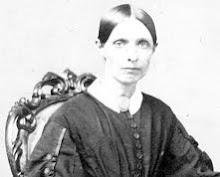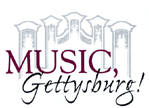
Here's what we discovered:
"Company B of the 21st Pennsylvania Cavalry, known as the "Adams County Cavalry" during Gettysburg and as "Bell's Cavalry" after the Campaign, has two monuments, both of which are within 30 yards of each other on the Baltimore Pike. They are on the east side of the road and in the area that was known as "McAllister's Field," about 200 yards south of Colgrove Avenue and across from Powers Hill.
The 21st was organized to serve six months, just prior to the battle, as part of the general militia mobilization to meet the threat of General Robert E. Lee's invasion of the State. It was recruited from volunteers who were already at Harrisburg for the purpose of mustering into a unit, and was made up of a small nucleus of veterans of the 21st Cavalry as well as militia-trained youngsters from the immediate boroughs surrounding Gettysburg. The unit was organized from the counties of Adams, Cumberland, Chester, Dauphin, Franklin, Lancaster, Lebanon, Mifflin, Montgomery, Philadelphia, and York. The members were mustered in at Camp Curtin in Harrisburg, and in Philadelphia, on June 21, 1863. The commander of the Adams County Cavalry was Captain Robert Bell. On June 24, in Gettysburg, Major Granville O. Haller officially swore in the unit for State service for a term of six months. They became Company B of the 21st Pennsylvania Cavalry in August.
Bell was born in Menallen Township in northern Adams County in 1830, descended from Scots-Irish settlers from the mid-1700's. Several of his ancestors had served during the Revolution. When Bell enlisted in his company in June of 1863, he was married to Abigail King, and was a farmer. He served through the war until July 1865 and returned to farming, also working as a cashier in Gettysburg's bank.

A citizen of Adams County, George W. Sandoe, enlisted in the Adams County Cavalry. However, his service would be short-lived. On the evening of June 25, 1863, the unit moved into town and picketed all the roads north, east, and south. Bell was given the assignment of moving west toward Chambersburg to reconnoiter as far as Cashtown. They then moved back into Gettysburg after spotting advanced Confederate Cavalry along the Chambersburg Pike. They posted videttes throughout the town on the morning of the 26th to cover all approaches. Accompanying Captain Bell was Major C.M. Knox, adjutant to Major Granville O. Haller, commanding officer of the District of Susquehanna. On Major Knox's request, most of Bell's cavalry company pulled back amid light skirmishing as the 26th Pennsylvania Militia also withdrew. The troopers successfully covered the flanks of the 26th Militia as that unit pulled back on the railroad grading through town. As elements of Confederate General Jubal Early's Division entered the town of Gettysburg, the first Confederate force to do so during the Campaign, one of Early's brigadiers, John B. Gordon, sent out pickets to patrol the roads radiating from the town to the south and east. In this vicinity were green troopers of the Adams County Cavalry, who had failed to get the order to pull back. Private Sandoe was posted on the Baltimore Pike near the Nathaniel Lightener home, sitting on his horse and talking with Daniel Lightener, son of Nathaniel. A scrub growth of bushes and trees blocked the view of Confederate pickets from Colonel Elijah White's 35th Battalion of Virginia Cavalry from them. The pickets ordered them to surrender. Sandoe's companions jumped their horses back over a fence and escaped. As Sandoe tried to do the same while firing, his horse stumbled and fell. Recovering, Sandoe spurred the horse, trying to escape, but was shot in the head and lay dying in the Pike, just two miles from his home. Just six days after enlisting in the Union Army, and only three days after being mustered in, Sandoe became the first Union casualty in the Gettysburg area during the Campaign. Thousands more would follow him just days later. Sandoe today is interred in the Mount Joy Church Cemetery in Mount Joy, Adams County, just south of Gettysburg.
 He is shown in the photograph taken soon after his wedding with his wife Anna Caskey Sandoe. This view was taken circa 1862 and is courtesy of Fred Hawthone.
He is shown in the photograph taken soon after his wedding with his wife Anna Caskey Sandoe. This view was taken circa 1862 and is courtesy of Fred Hawthone.Elizabeth Thorn, caretaker of Gettysburg's Evergreen Cemetery in her husband's absence, left an account from the trooper of White's Battalion who shot Sandoe. As the trooper afterward led Sandoe's horse toward the Cemetery, he was asked about the extra horse. "Yes," replied the Virginian, "the -- shot at me, but he did not hit me, and I shot him and blowed him down like nothing, and here I got his horse and he lays down the pike."
The strength of the Adams County Cavalry was 76. Sandoe was the one trooper killed, 9 were wounded, and two missing. The troopers carried Sharps and Burnside carbines, with Colt .44 revolvers.
Both of the monuments are located in the area where Sandoe was shot and killed. The monument above on the right was erected first, and is the State Memorial, using state appropriation in the amount of $1500. Atop the base is a highly polished granite ball inset with a sculpture of a mount's head. A year later, veterans of the unit erected the second monument, above left, atop a cluster of boulders slightly further south on the Pike. Funds for this monument were raised privately, the motivation likely being that this would allow officers of the unit to place their names on this monument (at the time, no names were permitted on state-appropriated monuments).
The first monument was dedicated on October 5, 1893, and was sculpted by Edwin Elwell. It is made of Connecticut granite. The second monument was dedicated on October 4, 1894, containing a sculpture of a horse's head inside a large horseshoe, and tells the story of Private Sandoe.
After the battle, in August, Bell's company was made Company B of the 21st Pennsylvania Cavalry as was detailed as Provost Guard on the Gettysburg Battlefield. They were ordered to search for misappropriated government property under the direction of the quartermaster in town. Bell acted as Provost Marshal at Gettysburg until at least December, 1863, with his company performing the duties of military police and sentinels in the town and at Camp Letterman, the Federal hospital established north of town."
Courtesy of J. David Petruzzi from his website the Buford's Boys


















No comments:
Post a Comment